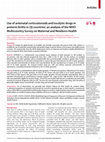Papers by Togoobaatar Ganchimeg
PLoS ONE, 2014
Background: Small for gestational age (SGA) is not only a major indicator of perinatal mortality ... more Background: Small for gestational age (SGA) is not only a major indicator of perinatal mortality and morbidity, but also the morbidity risks in later in life. We aim to estimate the association between the birth of SGA infants and the risk factors and adverse perinatal outcomes among twenty-nine countries in Africa, Latin America, the Middle East and Asia in 359 health facilities in 2010-11.
PLoS ONE, 2014
Background: Pre-eclampsia has an immense adverse impact on maternal and perinatal health especial... more Background: Pre-eclampsia has an immense adverse impact on maternal and perinatal health especially in low-and middleincome settings. We aimed to estimate the associations between pre-eclampsia/eclampsia and its risk factors, and adverse maternal and perinatal outcomes.
The Lancet, 2013
Background We report the main fi ndings of the WHO Multicountry Survey on Maternal and Newborn He... more Background We report the main fi ndings of the WHO Multicountry Survey on Maternal and Newborn Health (WHOMCS), which aimed to assess the burden of complications related to pregnancy, the coverage of key maternal health interventions, and use of the maternal severity index (MSI) in a global network of health facilities.
BJOG: An International Journal of Obstetrics & Gynaecology, 2014
Objective To assess the association between advanced maternal age (AMA) and adverse pregnancy out... more Objective To assess the association between advanced maternal age (AMA) and adverse pregnancy outcomes.
BJOG: An International Journal of Obstetrics & Gynaecology, 2014
Objective To assess the relationship between education and severe maternal outcomes among women d... more Objective To assess the relationship between education and severe maternal outcomes among women delivering in healthcare facilities.
BJOG: An International Journal of Obstetrics & Gynaecology, 2014
BJOG: An International Journal of Obstetrics & Gynaecology, 2014
Objective To describe the mode and timing of delivery of twin pregnancies at ≥34 weeks of gestati... more Objective To describe the mode and timing of delivery of twin pregnancies at ≥34 weeks of gestation and their association with perinatal outcomes.
BJOG: An International Journal of Obstetrics & Gynaecology, 2014
Objective To illustrate the variability in the use of antibiotic prophylaxis for caesarean sectio... more Objective To illustrate the variability in the use of antibiotic prophylaxis for caesarean section, and its effect on the prevention of postoperative infections.

Lancet, Jan 22, 2014
Despite the global burden of morbidity and mortality associated with preterm birth, little eviden... more Despite the global burden of morbidity and mortality associated with preterm birth, little evidence is available for use of antenatal corticosteroids and tocolytic drugs in preterm births in low-income and middle-income countries. We analysed data from the WHO Multicountry Survey on Maternal and Newborn Health (WHOMCS) to assess coverage for these interventions in preterm deliveries. WHOMCS is a facility-based, cross-sectional survey database of birth outcomes in 359 facilities in 29 countries, with data collected prospectively from May 1, 2010, to Dec 31, 2011. For this analysis, we included deliveries after 22 weeks' gestation and we excluded births that occurred outside a facility or quicker than 3 h after arrival. We calculated use of antenatal corticosteroids in women who gave birth between 26 and 34 weeks' gestation, when antenatal corticosteroids are known to be most beneficial. We also calculated use in women at 22-25 weeks' and 34-36 weeks' gestation. We ass...

Uploads
Papers by Togoobaatar Ganchimeg